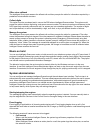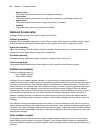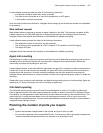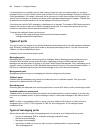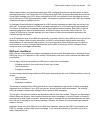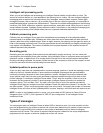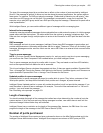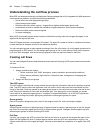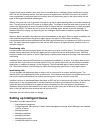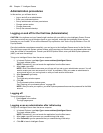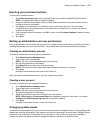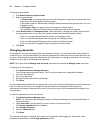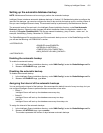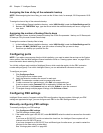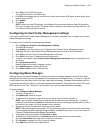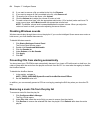Setting up Intelligent Queue 427
A caller should never receive a busy tone from an available queue. Intelligent Queue handles an incoming
ACD call with the following actions: the caller receives a ringback tone, the RAD timer starts, the interflow
timer programmed in the queue starts, the overflow timer for the primary group in the queue starts, the call
goes to the longest idle/highest skilled agent.
When a trunk picks up a call, it forwards it through to a group of agents handling calls or to another answering
point. The call arrives at the ACD queue of an agent group. The length of time the caller waits in queue is the
queue time. While waiting in queue, the caller listens to product features, announcements, or other messages
provided by a RAD. The caller can wait in queue for an available agent, leave a voice mail message, or
abandon the call by hanging up, depending on how Intelligent Queue and the telephone system have been
programmed.
When an agent is available, the customer connects immediately to the agent. When no agent is available, the
caller automatically queues to the primary agent group in the queue. In both cases, the caller’s
communication path remains unaffected and the caller remains listening to its ringback tone, RAD or music on
hold. The caller receives a ringback tone until the first RAD answers, an agent answers, interflow occurs, or
the caller hangs up.
Overflowing calls
A queue contains one primary agent group and can have up to three overflow groups. The overflow groups
provide backup resources to the primary agent group to ensure that service level goals are met. Calls that
overflow maintain their position in queue. Agent group overflow timers determine how long a call waits before
overflowing.
Intelligent Queue places an ACD call that is not answered immediately in a queue. If an agent does not pick
up the call after a set amount of time (the overflow time), the system places the call in the queue of another
agent group, in addition to keeping it in the first group. The first available agent in either group handles the
call. The overflow feature limits the delay for callers by queuing calls against two or more agent groups.
Interflowing calls
You can program the telephone system to direct a call to voice mail or to another answering point. The
interflow timer runs independently of the overflow timer. If the interflow timer expires, the system removes the
call from the queue and redirects it to another answering point, such as a trunk or voice mail.
Interflow is a time- or load-based feature that takes an ACD call out of the queue and routes it to the interflow
answer point (if one is programmed). A call that interflows to another queue adopts the priority of the =>
queue and does not look back for an agent to become available from the initial queue in the following
instances: the new queue has Interflow to this path uses this path priority set to Yes in its Path Assignment
form, or the call interflows from a queue that has a priority of 64.
Otherwise, the call’s priority does not change.
Setting up Intelligent Queue
This section includes information on
• Administration procedures
• Configuring ports, PBX settings, Contact Center Management settings, Music Manager, and Updated
position in queue
• Managing actions
• Managing conditions
• Managing call flows
• Managing port groups
• Viewing the status of a queue



